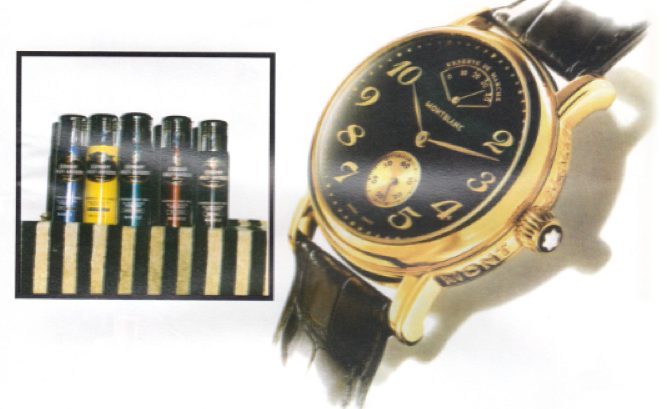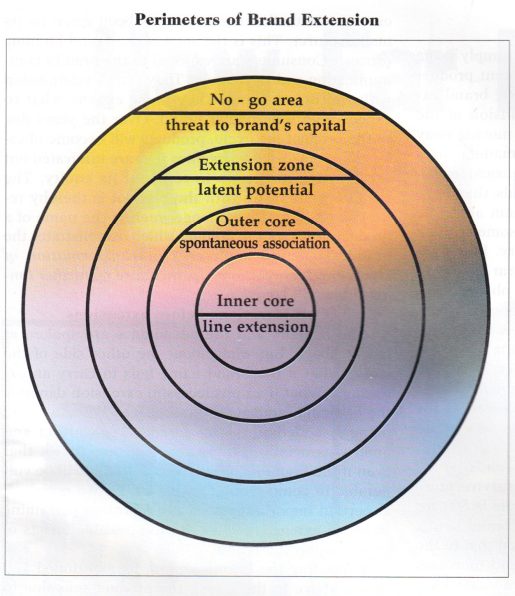Ajai V Singh

If you carefully observe the visuals above, you will see the name ‘Harley Davidson’. What will come to your mind, is the image of big, legendary and rugged American motorcycles envied the world over. But, isn’t there something wrong! The visuals show a range of deodorants instead of motorcycles. Now check the other visual, the name Mont Blanc is associated with writing instruments rather than with watches. What are these brands doing in strange territories? They have simply embarked on the path of ‘Brand Extension’. This article endeavors to highlight the important considerations of brand extension, the effects of brand extension and the territory within which the brand should extend.
Why Brand Extension?
First, what is brand extension? It is simply using an existing brand name to enter a different product class or category. Though, many confuse brand extensions with line extensions or expansion of the existing range of products, extension is moving away from the existing technology. Yamaha manufactures motorcycles and it also manufactures musical instruments. If we go about observing brands that have extended, we will find that some of them are quite close to their initial territory, whereas some of them have extended far beyond their territory. Brand extensions are a natural strategy for the firm looking to grow by exploiting its assets. There are obvious benefits attached to brand extension as opposed to entering a new product category with a new name. It is financially very viable since the advertising and brand image building costs are reduced. The new brand will pose barriers in the consumer’s mind about what to expect from the product, a foggy perception about the brand’s benefits and simply what does this brand stand for.
An OC&C (a body that monitors brands) study showed that only 30% of new brands survive more than four years, whereas, the survival rate is 50% for a new product sold under an existing brand name. Another study by the same body revealed that in the grocery market, an already-known brand increases the trial rate and the repeat purchase rate considerably.
Conventional concept that ignores extensions
There are many companies which ignored brand extension when it came to their products. They opted to go with the classic brand concept that simply says one brand will only endorse a single product, which in turn promises a single benefit to its consumer. These companies either acquire companies who al ready have a successful product or through intensive R&D produce a product that gives one strong benefit. The giant, P&G conforms to this concept, Pantene shampoo, the world’s largest selling shampoo (recently launched in Sri Lanka) promises a benefit through a shampoo and it will always remain that way. This name will never endorse another product. It is a very conservative concept. In many cases it may lead to under utilization of the brand name.
Under utilization is when the brand’s capital and equity is not exploited to its potential. To elaborate the classic brand concept further, the brand when endorsing a single product has potential to extend. This can be explained further, from the very basic stage when the product is actually developed and manufactured, it is given a name. Through its physical appearance and communication, an identity building process starts. Consumers start to look at the product and its benefits (promise). They start associating it with the name that has been given by its manufacturer. This is the start of the brand building process. Consumers are exposed to the brand’s communication and its product. They start a relationship with the brand name. They know exactly what to expect from a particular brand. Over the years due to the product life cycle, products will become obsolete and replaced by new ones that are innovated but the brand name grows in terms of its equity. The brand’s relationship with the product is thereby reversed, the brand is no longer merely the name of a product, it is now the product which demonstrates the brand. To quote Kapferer ‘On transformation of brand-product relationship, there are no further limits to brand extension.”
Considerations before extensions
The benefits and the advantages are spoken at length above. But what about the other side of the story. What if the brand name fails to carry an extension? What if an unsuccessful extension damages the original brand’s name and image? When a brand name is added simply to provide recognition and quality association, there is a substantial risk that even if the brand is initially successful, it will be vulnerable to competition (Aaker, 1991). We now look at certain important issues and learnings pertaining to brand extension. They are the possible effects of extension on the brand:
Exploiting the brand capital, as mentioned and shown above in the visual, the product sells due to the existing brand name. It is the loyalty attached the brand that motivates the consumer to try the product. For example, Maliban milk powder, Marlboro’s men’s wear called Marlboro classic.
Destroying the brand capital, if the new product does not conform to the philosophy and the values of the brand name it will eventually destroy the loyalty and the expectations the consumer has attached. to the brand. For example, extensions pursued by designer Pierre Cardin are affecting his brand’s equity.
Some extensions just do not affect the brand, in these cases because of the consumer’s perception there is a neutral effect. To elaborate, the existing brand associations show hope to the consumers that some day, if not already, this brand will embrace a particular product. That product will have the same principles and values as the brand. This extension is expected by the consumer.
Extensions can enhance the core brand. They can revamp the brand and its basic values in a new and powerful way.
Whatever the effects, what is important to remember is that a brand is put under a lot of stress through extension. Kapferer has developed a very effective model that demonstrates the perimeters of brand extension:

Inner core shows the most obvious expansion, the line extension. Consumers expect that. That is virtually the brand’s territory. Once the brand moves out of that territory, it reaches the outer core. The brand is exposed to spontaneous associations, which are very close to the brand’s core values. These core values reflect on the products that the brand can endorse. Extension zone, is based on the potential of the brand to tread into this unknown territory. Potential is gauged through intensive research and considering the brand’s character and core values, action is sought. The last is the no-go area, which is a threat to the brand’s capital asset. The implementation of this model is only possible after a very thorough quantitative and qualitative inquiry is carried out, to clearly understand the brand’s attributes, personality, purpose, its heart, contract it offers its consumers and its latent potential.
Some examples of brand extension are of Harley Davidson moving into men’s toiletries, Mercedes Benz opening a boutique that sells clothes, accessories and perfumes, Jaguar venturing into men’s after shaves and eau de cologne and Marlboro moving into menswear. If we closely look at the Harley Davidson range, the brand has kept intact its character and its core values. The brand has a character and personality that personifies masculine ruggedness. Harley Davidson has managed to bring these values across the product category.
To conclude, extension always involves a certain risk, no form of study can accurately predict the effect of extension on the brand itself over a period. Nevertheless, the attraction of levering the brand name is irresistible and this has been proved by numerous brands world over. If extensions are done keeping in mind the core brand’s values and its extension perimeters, the intended extension has a strong possibility of being successful.



